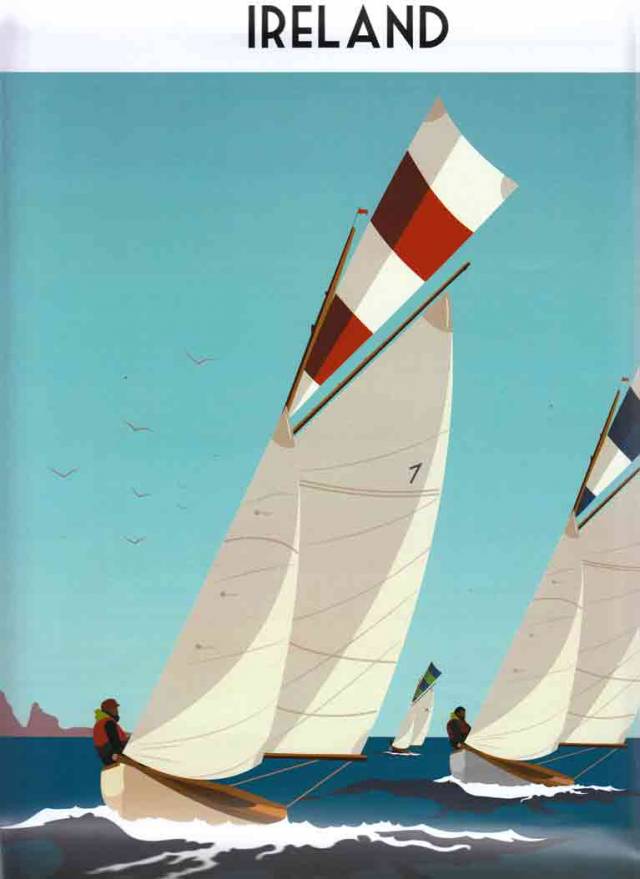Three weeks hence from this morning, on Saturday May 19th, an unlikely convoy of vehicles with a very special collection of unique vintage boats and people will emerge in Cherbourg from Irish Ferries’ ship just in from Rosslare writes W M Nixon. Meanwhile, well to the west in northern Brittany, a similarly rare group with antique boats of a different type will have disembarked in Roscoff from the Brittany Ferries vessel from Cork. By that night, if all goes according to plan, both groups – people and boats alike - will be united a long way away, in the little port of Arradon on the shores of the Morbihan, the island-studded inland sea at the heart of its own Department, the most southerly part of Brittany.
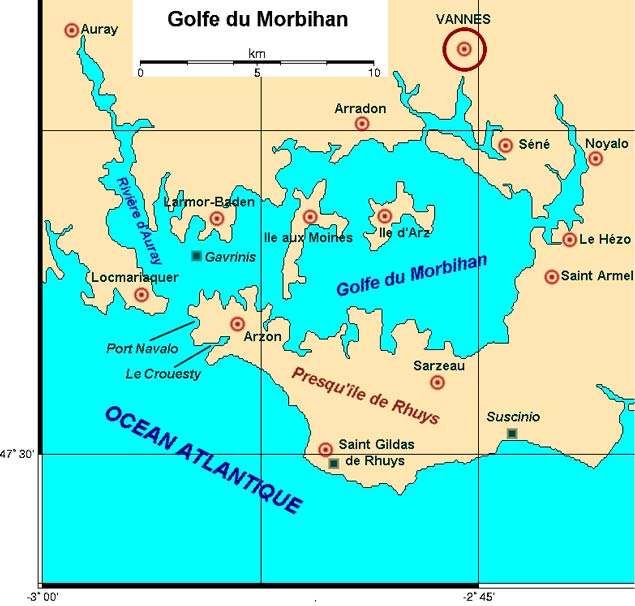 A sailing paradise. In detail, there are sixty islands in the Morbihan. The Irish crews in the Water Wags and Howth 17s will be based at Arradon on the north shore.
A sailing paradise. In detail, there are sixty islands in the Morbihan. The Irish crews in the Water Wags and Howth 17s will be based at Arradon on the north shore.
The Irish classic boats and those who sail them will have arrived to immerse themselves in the fleet of more than 1,300 other unusual craft in a very French celebration of sailing and pride in individualistic boat ownership. It’s a wonderfully complex biennial celebration which uses the magic waters of the Morbihan, where sea and land completely intertwine in the midst of the sweetest countryside with enchanting village ports, to provide a unique playground for boats of all types and sizes.
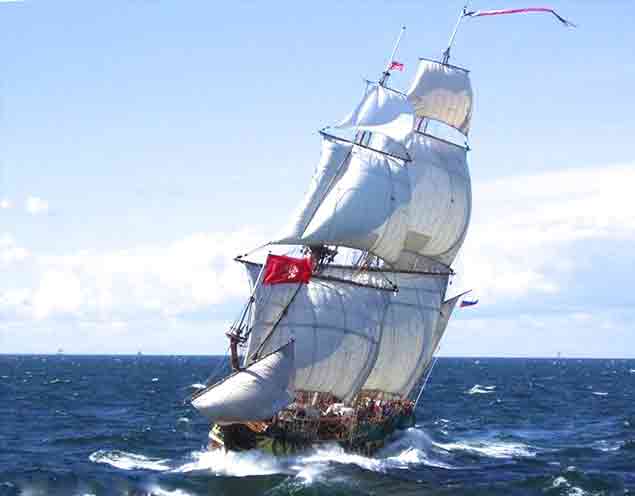 The replica of Peter the Great’s 1703-built Shtandard will be one of the largest vessels at the Morbihan.
The replica of Peter the Great’s 1703-built Shtandard will be one of the largest vessels at the Morbihan.
At the time of writing, they’re expected to range in size from the extraordinary Russian re-creation of Peter the Great’s huge warship of 1703, the Shtandart, right down to a selection of the sometimes decidedly unusual yet effective little craft which emanate from the creative minds to be found in Francois Vivier’s design office. In between, we’ve everything from the America’s Cup 12 Metre France through a comprehensive selection of traditional sailing fishing boats and classic yacht from several maritime nations, and on through a goodly fleet of other traditional craft with a strong representation of the Bantry Boats, until at the lower end of the size scale, we find some little boats which are very odd indeed, owner-designed craft which can best be categorized somewhere on the scale which ranges from Rather Quirky to Utterly Bonkers.
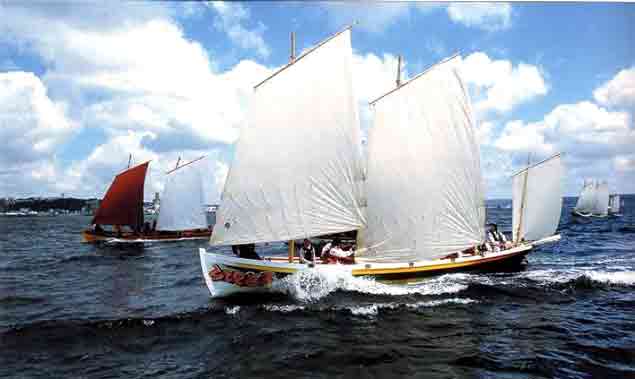 Bantry Boats racing in France. Based on the ship’s boat left behind in Bantry Bay after the failed invasion of 1796, the Bantry boat was stored for more than a hundred years at Bantry House before being moved to the National Museum. Under an iniative inspired by Hal Sisk, they are now the basis of a lively fleet on both sides of the Atlantic, and will be a feature of the Morbihan Week.
Bantry Boats racing in France. Based on the ship’s boat left behind in Bantry Bay after the failed invasion of 1796, the Bantry boat was stored for more than a hundred years at Bantry House before being moved to the National Museum. Under an iniative inspired by Hal Sisk, they are now the basis of a lively fleet on both sides of the Atlantic, and will be a feature of the Morbihan Week.
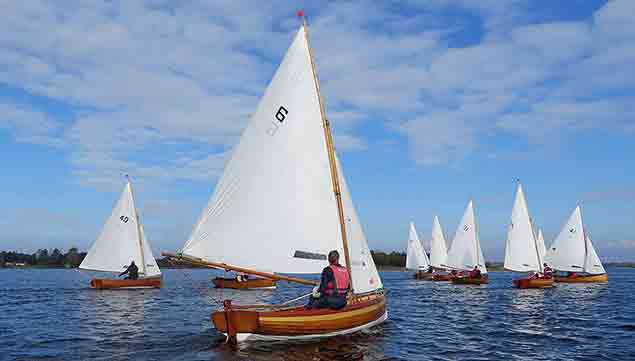 They’re in better heart than ever. The Water Wags at a recent “training weekend” at Killenure on Lough Ree. Next month they will be making their second visit to the biennial Morbihan Week in southern Brittany.
They’re in better heart than ever. The Water Wags at a recent “training weekend” at Killenure on Lough Ree. Next month they will be making their second visit to the biennial Morbihan Week in southern Brittany.
In the midst of the huge fleet, there’ll be twelve Water Wags and six Howth 17s from Ireland. Small and all as they are by comparison with some of the enormous traditional fishing craft and Tall Ships taking part, they will be accorded honoured status partly on account of age. The Water Wags of 1887 origin, with the present class a re-worked larger design from 1900, introduced the One-Design concept. And as the Howth 17s are of 1898 origin, they are accorded the special honour of being the world’s oldest one design keelboat class still sailing as originally designed.
 Howth 17s in full cry. They will be making their first visit to the Morbihan festival, but their newest sister-ship is being built nearby at Skol ar Mor.
Howth 17s in full cry. They will be making their first visit to the Morbihan festival, but their newest sister-ship is being built nearby at Skol ar Mor.
Further to all that, both classes bring international status through coming from Ireland, and few have come further, even if the little Irish boats are sensibly using the ferries. But we will also see Irish Sea representation with boats which have sailed there, with the beautifully restored classic Laurent Giles-designed Carbineer 46 Sylvana voyaging from Northern Ireland, while the irrepressible Joe Pennington from the Isle of Man is entered with his restored 1895-built 36ft Manx longliner Master Frank, which might find it interesting to have a spot of competition with the comparable French-based Essex smack Unity of Lynn.
However, for the little Irish boats, it’s a formidable logistical challenge. The Water Wags - in which the Olympic Mother Cathy MacAleavey has been setting the racing pace of late, though David MacFarlane won on Wednesday – are in good hands as Carol O’Rourke is coordinating their arrangements. But anyway they’ve useful experience here, as seven of them travelled to the 2015 Semaine du Golfe du Morbihan, and eight came back. They returned with a new boat for Adam Winkelmann which had been built to the class’s ancient designs by Mike Newmeyer and his team at the inspirational boat-building school Skol ar Mor.
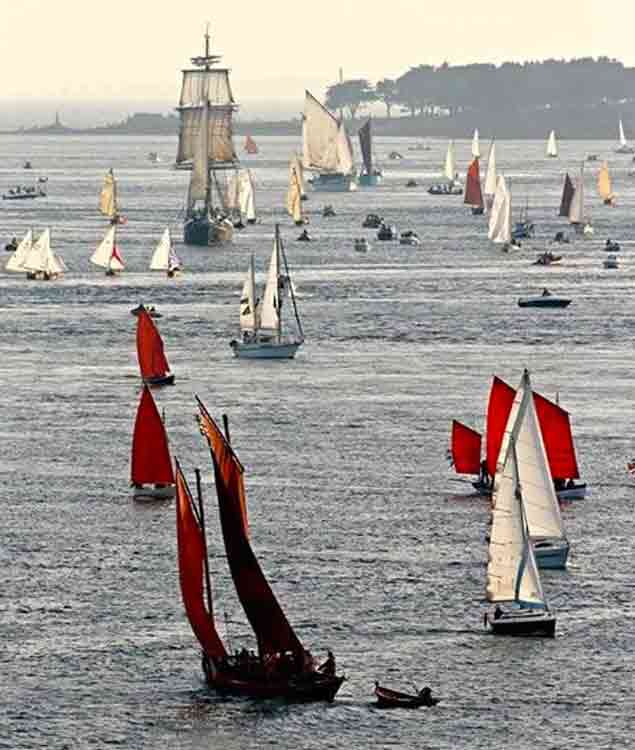 Eclectic fleet......the Morbihan Fesitval in 2015. Four of the Water Wags are just about visible left centre
Eclectic fleet......the Morbihan Fesitval in 2015. Four of the Water Wags are just about visible left centre
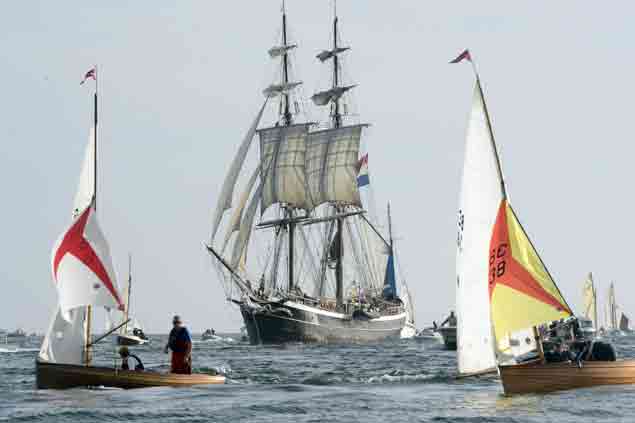 The popular Dutch sail training ship Morgenster was a welcome visitor to the festival in 2015, and is seen here approaching the entrance to the Morbihan in company with a couple of Water Wags
The popular Dutch sail training ship Morgenster was a welcome visitor to the festival in 2015, and is seen here approaching the entrance to the Morbihan in company with a couple of Water Wags
Skol ar Mor – which is located near the entrance to the Morbihan – is currently building a new Howth 17 for Ian and Judith Malcolm, but she won’t be finished until July as her construction is timed to phase in with the school’s term periods. But in any case, the Malcolms are keen to make their debut for the Howth 17s at Morbihan with their 1898-vintage boat Aura, which they’ve owned, lovingly cared for and raced very regularly since 1980.
It’s not the first time the Howth 17s have travelled far from their ancestral home, in fact it’s not the first time they’ve been to France, as a trio went to the Brest Festival in 1972. But road travel technology for little old boats wasn’t so advanced 45 years ago, so it wasn’t until 1998 that another road migration was taken on, with seven of them going to Belfast Lough to celebrate their centenary at their birthplace at Carrickfergus. They sailed the 90 miles home.
Then in 2005 they’d a seriously major movement, when an incredible 15 managed to get to the Glandore Classics involving an efficiently-organised set of low loaders which could take the boats down to West Cork three or even four at a time.
The Howth 17s are nothing if not individualistic, so the regimentation essential to the success of this expedition was exhausting for them. It took a while for the normal busy season of racing (usually they’ve sixty races a year) to resume once they’d got home. So since then, they’ve been building up a group of owners within the class who have proper road trailers, and that was the means used to get seven boats to Belfast Lough for last year’s 150th Anniversaries of Carrickfergus Sailing Club and Royal Ulster Yacht Club, together with the celebration of the yacht and boat-building achievement of the John Hilditch yard at Carrickfergus.
 The opportunity to compare different rigs and boat types at the Morbihan is unrivalled. This is the Looe Lugger Our Boys of Plymouth..........
The opportunity to compare different rigs and boat types at the Morbihan is unrivalled. This is the Looe Lugger Our Boys of Plymouth..........
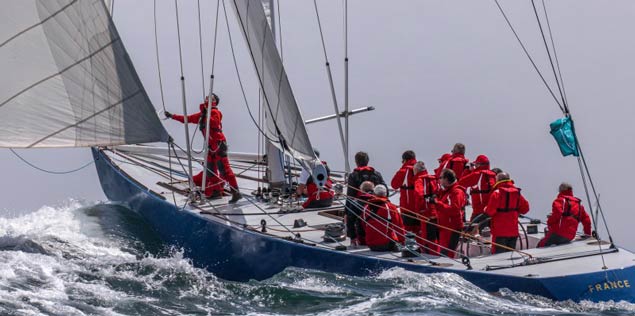 ......and this is the former America’s Cup 12 Metre France
......and this is the former America’s Cup 12 Metre France
But there’s a heck of a difference between taking just part of a morning to road-trail mostly on motorways from Howth to Bangor, and trailing your boat from Dublin to the Morbihan via the Rosslare-Cherbourg ferry. The Water Wags know they can do it, but for the much heavier Howth 17s and their interesting selection of four-wheel-drive towing vehicles, they’re facing a total haul of 540 kilometres, 348 of them in France.
Naturally, there are those who’ll say that boats of this vintage should live pampered lives. But the Howth 17s are nothing if not adventurous, and Irish Ferries have been so much taken with all this that four of the boats and their towing vehicles are travelling the ferries there and back for free, so between them the six travelling equipes have only had to divvy up for two boats’ cost.
Nevertheless as two of the boats – Aura and Roddy Cooper’s Leila - are from the original 1898 Hilditch-built five, they’re moving a uniquely precious cargo on a project very far removed from their origins. So far removed, in fact, that I can’t help but imagine John Hilditch urging on his men on a Monday morning early in the Spring of 1898 with the inspiring words: “C’mon, lads, we have to build these new Howth boats strong and true, for in 119 years time their owners will want to trail them the 217 miles from Cherbourg to Vannes on some sort of road cart.”
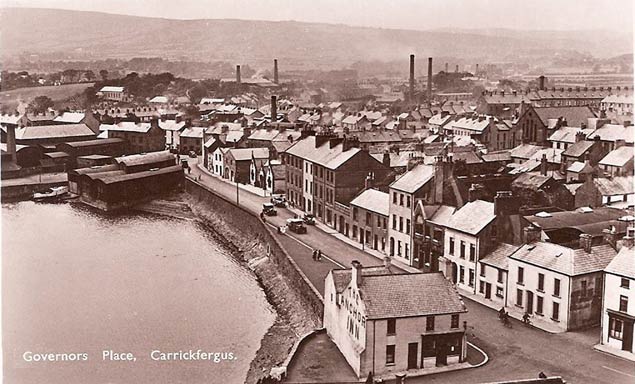 Change of scene. The Howth 17s were built in Carrickfergus in 1898 in Hilditch’s Boatyard in those black sheds on the waterfront at the head of the harbour in an industrial town.......
Change of scene. The Howth 17s were built in Carrickfergus in 1898 in Hilditch’s Boatyard in those black sheds on the waterfront at the head of the harbour in an industrial town.......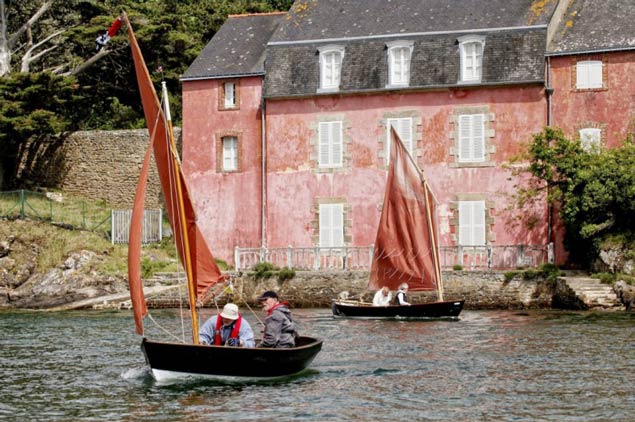 ....but next month they’ll be sailing in these agreeable surroundings in the heart of the Morbihan
....but next month they’ll be sailing in these agreeable surroundings in the heart of the Morbihan
Quite. Either way, it will be an exhausting journey, but it’s the sort of project which re-energises those involved as it moves along, and once they’ve got to the Morbihan, the Water Wag and Howth 17s sailors will find themelves among kindred spirits. It’s something they need from time to time. Only the other day I was asked to reveal to a non-sailor what the Water Wags are all about in 2017, and found it very challenging. For how can you explain the inexplicable?
Around the Morbihan, there’ll be no need to explain. Yet even in France supposedly among members of the same nautical religion, the Howth 17s and the Water Wags will find themselves slightly at odds with the crew of some other boat types, as the essence of both the Irish classes is that they race a lot, so much so that both classes are healthier than ever. But that is not always to the taste of all those who simply love old boats for themselves, and find that keeping them in good order and sailing them in non-competitive style on various expeditions within the ambit of the Semaine du Golfe du Morbihan is all that is required.
But the Morbihan has so much to offer that there’s something for everyone, and for smaller racing boats that want racing, there’ll be racing available. As for others who simply like sport in sailing challenging bits of sea, the tides in the Morbihan whoosh in and out through the narrow entrance with such vigour that many treat it like a nautical ski slope.
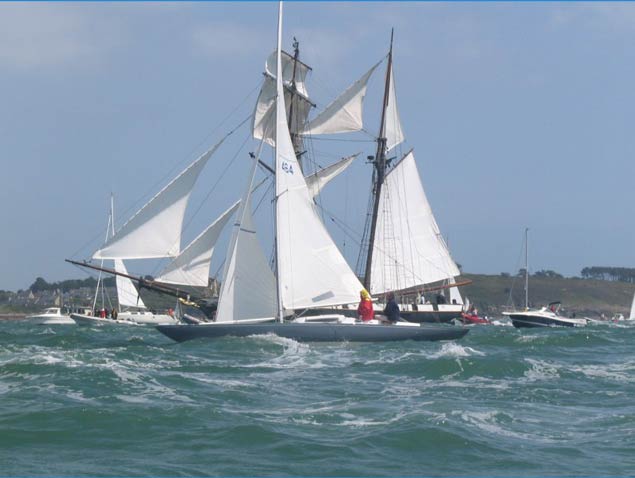 The manageable liveliness of the tide-riven waters in the Morbihan entrance is integral to the way the event is staged.......
The manageable liveliness of the tide-riven waters in the Morbihan entrance is integral to the way the event is staged.......
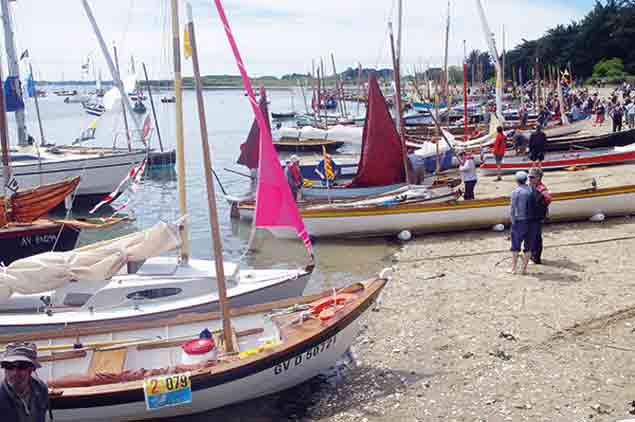 ......but for balance, sheltered beach time is expected
......but for balance, sheltered beach time is expected
This is markedly unlike the attitude at the entrance to Strangford Lough. There, the tide-race on the bar is admittedly on a bigger scale, but it’s regarded as something to be avoided. At the Morbihan by contrast, there are small boat sailors who’ll spend their whole day crawling in the eddies against the tide, and then returning with it in the middle of the full exuberant burst of the rip.
For those with more leisurely tastes, there are all sorts of waterside establishments where lunch can go on for ever, but be very sure to have secured your table by 12:30pm. And as for visiting other boats, that too can go on for ever.
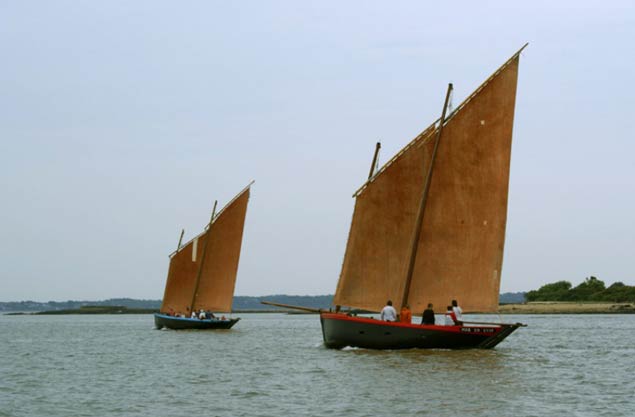 The sinagot is the indigenous traditional fishing boat of the Morbihan
The sinagot is the indigenous traditional fishing boat of the Morbihan
Certainly there are some with which the Howth folk should link up. A noted presence will be the McGruer 8 Metre Cruiser/Racer Orana of 1959 vintage. For many years she was based in Howth under Johnny Pearson’s ownership, and she had her moments, including winning the 1966 RORC Beaumaris-Cork Race overall. She was the first yacht I ever did the Lambay Race aboard, and when you do your first Lambay Race with the likes of Johnny Pearson, Bob Fannin and Brendan Murray, you learn an awful lot about what living in Howth is going to involve, and you even learn a little about racing round Lambay.
 The 1959 McGruer-designed 8 Metre Cruiser-Racer Orana was Howth-based for many years, and was overall winner of the 1966 RORC Beaumaris-Cork Race. After being under the radar for decades, she has re-emerged in French ownership as a participant at Morbihan Week 2017
The 1959 McGruer-designed 8 Metre Cruiser-Racer Orana was Howth-based for many years, and was overall winner of the 1966 RORC Beaumaris-Cork Race. After being under the radar for decades, she has re-emerged in French ownership as a participant at Morbihan Week 2017
Orana had been off the radar for decades, but now she has re-emerged, spic and span in French ownership and ready to strut her stuff in the Morbihan in three weeks time when she’ll be part of a mind-blowing feet. In fact, so diverse is the fleet, that while most of it will be the challenge of recognising what’s going past, some are worth seeking out directly, and one such is surely the famous Pen Duick, Eric Tabarly’s original boat, a Fife-designed 15-tonner which started life in 1898 at Carrigaloe on Cork Harbour.
Originally, she was given the unlovely name of Yum, and her owner, one Adolphus Fowler of the Royal Munster YC, was evidently feeling prosperous, for at the same time he had the Carrigaloe yard built him the Cork Harbour One Design Jap.
Both boats still sail the sea, but mercifully Yum soon received a pleasanter name as she was quickly sold, and she is now immortalised as Pen Duick, the eternal beauty brought back to life by Eric Tabarly to be an extraordinary link between William Fife of Scotland, Cork Harbour in Ireland, and all that is best in French sailing in Brittany.
In a league like this, the little boats from Ireland will need to do something special to fulfill their role. But I think that the poster that the Howth 17s commissioned from local artist Carol O’Mara for display on the various sites around the Morbihan is definitely a step in the right direction. There’ll be so many messages flying around from all sources that something which says what it wants to say so well, so simply, and so directly will make the most impact.




























